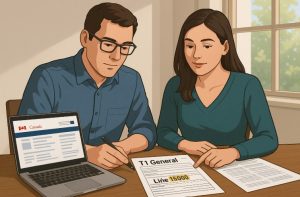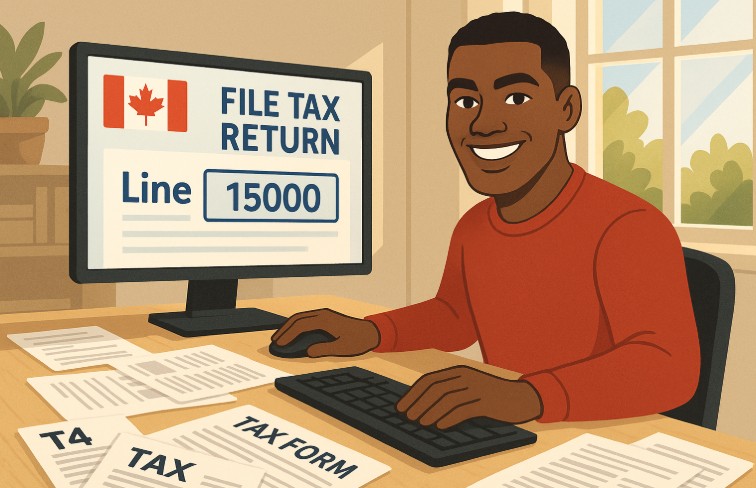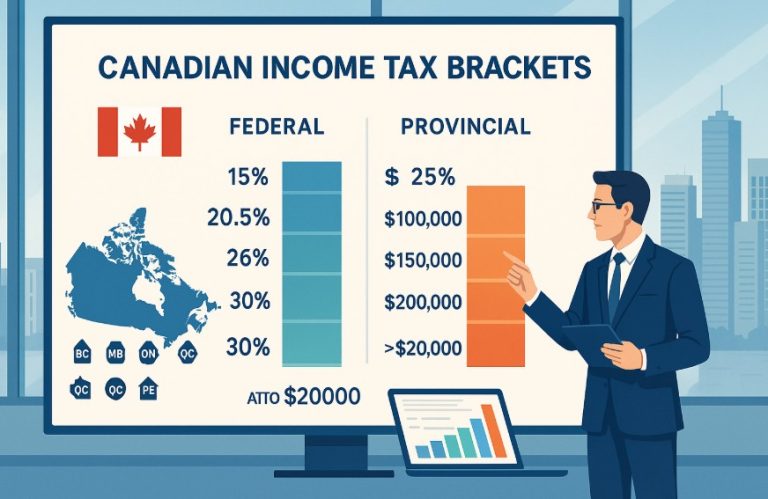Have you ever looked at your tax return and wondered what Line 15000 actually means? If you’re like many Canadians, tax forms can feel overwhelming, but understanding this line is critical. Line 15000, formerly known as Line 150, is where you report your total income before any deductions.
This number is key to calculating how much tax you owe and whether you qualify for various government benefits. Whether you’re employed, self-employed, retired, or a newcomer to Canada, your total income must be reported here. Knowing what goes into Line 15000 not only helps you file accurately but also ensures you don’t miss out on tax credits.
So, if you’re preparing to file your Canadian tax return or simply want to make sense of this crucial line, keep reading. This guide will break down everything you need to know about Line 15000 and why it matters to your financial life in Canada.
What Does Line 15000 Mean On A Canadian Tax Return?

Line 15000 on your Canadian tax return represents your total income for the year before any deductions like RRSP contributions, child care expenses, or moving costs are subtracted. This figure gives the Canada Revenue Agency (CRA) a clear picture of all your earnings and is the basis for calculating your taxable income.
The CRA defines total income as all revenue sources combined. This includes employment earnings, investment income, rental revenue, pension payments, and more. While some people might assume it only refers to their job salary, Line 15000 covers much more.
Here’s a quick snapshot of what’s included:
- Employment income (e.g., wages, bonuses)
- Self-employment income
- Investment income (e.g., dividends, capital gains)
- Pension and retirement payments
- Government benefits (e.g., EI, CPP)
- Rental income and foreign income
Accurate reporting of this line is essential. Line 15000 is often used to determine benefit eligibility, such as for the Canada Child Benefit (CCB) or the GST/HST credit. It’s also a reference point for verifying your identity when contacting the CRA. Essentially, it’s the financial cornerstone of your tax return.
What Types Of Income Are Included On Line 15000?
Your total income reported on Line 15000 includes several different types of earnings not just your salary. If you’ve made money in Canada or abroad during the tax year, chances are it belongs here. This comprehensive total affects how much tax you’ll owe and whether you’re eligible for government benefits or credits.
The most common income types found on Line 15000 include:
- Employment income: Wages, tips, commissions from employers (T4 slip)
- Self-employment income: Earnings from your own business or freelance work (T2125 form)
- Investment income: Dividends, interest, and capital gains (T3, T5 slips)
- Rental income: Profits from property rentals
- Pension and government benefits: CPP, OAS, EI, or other pension payments (T4A, T4E)
- Foreign income: Earnings outside of Canada, converted into CAD
It’s vital to include every source of income, even if it’s minimal. Failing to do so could result in a reassessment or disqualification from important benefits.
Breakdown Of Income Types With Corresponding Tax Slips
| Income Type | Tax Slip/Form Used |
| Employment Income | T4 |
| Self-Employment Income | T2125 (Self-Declared) |
| Investment Income | T3, T5 |
| Rental Income | Statement of Real Estate Income |
| Pension Income | T4A, T4OAS, T4CPP |
| Employment Insurance | T4E |
| Foreign Income | Supporting documents, currency converted |
Understanding where these earnings are documented helps you fill out your tax return correctly and avoid issues later.
Why Is Line 15000 Important For Your Tax Return?

Line 15000 plays a vital role in determining both your tax obligations and your eligibility for various government programs. While it doesn’t represent the amount you owe in taxes, it acts as the starting point for calculating your net income and, eventually, your taxable income.
This line is crucial because:
- It helps establish your federal and provincial tax bracket.
- The CRA uses it to assess your eligibility for benefits such as the GST/HST credit, the Canada Child Benefit (CCB), and other income-based assistance.
- It’s referenced by financial institutions during mortgage applications, loan assessments, and credit evaluations.
For individuals and families, Line 15000 serves as a foundation for financial planning. Overstating or understating your income could lead to inaccurate assessments, missed benefits, or even penalties.
It’s also one of the most requested figures when applying for income verification documents or when contacted by CRA for audits or corrections. Understanding and accurately reporting this line ensures a smoother tax experience and maximizes your financial entitlements.
How Do You Find Your Line 15000 Amount?
Finding your Line 15000 amount is straightforward if you know where to look. It appears on the T1 General Tax Return, usually on the first summary page. This total is automatically calculated when you enter all your income sources in your tax software or through a tax preparer.
Other places you can find this figure include:
- CRA My Account: Log in to view your past tax filings and your current year’s total income.
- Notice of Assessment (NOA): Sent by the CRA after processing your return, it clearly lists Line 15000.
- Income slips: Add up the amounts from all T4s, T5s, T4As, and other slips you received for the year.
If you’re unsure or need confirmation, you can also contact the CRA directly. They may ask for your SIN, date of birth, and total income reported on Line 15000 to verify your identity. Having this information ready ensures smoother communication with the agency and access to your tax information or adjustments.
How Is Line 15000 Different From Net Income?
It’s a common misconception that Line 15000 reflects your actual take-home or taxable income. In reality, Line 15000 is your gross income, the total before any deductions are applied. Your net income, reported on Line 23600, comes after allowable deductions.
Here’s the difference in simple terms:
- Line 15000: All income before deductions.
- Net Income (Line 23600): Line 15000 minus deductions like RRSP contributions, union dues, child care costs, etc.
- Taxable Income (Line 26000): Net income adjusted for certain tax-exempt portions or carry-forward credits.
Understanding this distinction is critical. Some benefits are calculated using net income, while others use total income. For example, the CRA may assess eligibility for the CCB based on your net income, but still require your total income for audit or verification purposes.
Misinterpreting these figures could result in incorrect tax filings or denied benefits, so it’s important to know which number applies in each context.
What Mistakes Should You Avoid When Reporting Line 15000?

Accurate reporting of Line 15000 is essential to ensure you don’t end up with tax penalties or missed benefits. Unfortunately, many people make preventable mistakes when completing this section of their return.
Here are some common issues:
- Forgetting small income sources: Freelance gigs, interest on bank accounts, or foreign income can easily be overlooked.
- Misreporting rental income: Many taxpayers report net rental income instead of the gross, which belongs on Line 15000.
- Ignoring foreign income: Even if earned abroad, Canadian residents must report all global income.
- Incorrectly categorizing income: Reporting capital gains or dividend income on the wrong line can lead to audits.
It’s essential to cross-reference all tax slips (T4, T5, T4A, etc.) and ensure that each source of income is captured. Using certified tax software or working with a qualified accountant can significantly reduce your risk of error. Double-check before submitting, as the CRA compares your return against slips they’ve received from third parties.
How Do Newcomers To Canada Handle Line 15000?
For newcomers, understanding Line 15000 can be daunting, especially if they’ve only been in Canada for part of the tax year. However, even partial-year residents are required to report worldwide income from the day they become a resident for tax purposes.
Here’s what newcomers need to know:
- You’re considered a resident for tax purposes once you establish significant residential ties in Canada (e.g., housing, spouse, dependents).
- You must file a tax return even with no income to qualify for benefits like the GST/HST credit or the Canada Child Benefit.
- Line 15000 should include all Canadian and global income from the date of your arrival.
- Foreign assets over CAD $100,000 must also be reported separately using form T1135.
Many new residents mistakenly believe they only need to report Canadian income. Failing to include global income can delay or invalidate your tax return. Be sure to collect all your income records and, if needed, seek help from free tax clinics or a certified accountant who understands immigrant tax needs.
How Can You Update Your Direct Deposit For Tax Refunds?
Starting March 24, 2025, the CRA is making changes to how you can update your direct deposit information. If you’re expecting a tax refund or benefit payment, having the right banking details on file is critical to avoid delays. After March 24, 2025, you will no longer be able to update or register for direct deposit by phone or through EFILE.
Instead, you’ll have to use one of the following options:
- Online via CRA My Account: This is the most efficient way to update your direct deposit details securely.
- Through your Canadian bank or credit union: Most major financial institutions offer this option.
- By mail: You can submit a direct deposit enrolment form directly to the CRA.
These changes are aimed at enhancing security and reducing fraud. Always ensure your personal details are accurate and up to date. This is especially important during tax season when millions of Canadians are expecting refunds, GST/HST credits, or other CRA payments.
What Services Can You Access Using Line 15000 Info?
Line 15000 isn’t just used to calculate your taxes, it’s also a vital number for verifying your identity with the CRA and accessing certain tax-related services. Knowing this figure can streamline your communication with the government.
Some key services that require your Line 15000 amount include:
- Telerefund: Check the status of your refund, estimated payment date, and refund amount using CRA’s automated phone service.
- Proof of income statements: Often used for immigration, housing, or student aid purposes.
- Personal Tax Account Balance: Review your account balance, past payments, and upcoming instalments.
When using these services, the CRA may ask you for:
- Your Social Insurance Number (SIN)
- Your birthdate or PIN
- The total income reported on Line 15000 for the most recent tax year
Having this information ready helps you quickly access services without delays. It also prevents identity verification issues when interacting with CRA representatives.
What If You Made An Error On Line 15000?

Making a mistake on your tax return, especially with a critical line like 15000, can feel intimidating. But the good news is that errors can be corrected, and the CRA provides several ways to amend a filed return.
If you discover a mistake after submitting your return, wait until you receive your Notice of Assessment (NOA). Once it’s processed, you can request a change:
- Online through CRA My Account
- Using Form T1-ADJ (T1 Adjustment Request)
- By mailing a signed letter detailing the correction
Whether you omitted income or reported an incorrect figure, these adjustments ensure your return is accurate.
How To Correct A Filed Return?
The fastest way is through CRA’s online portal. Navigate to “Change My Return” under the Tax Returns tab. There, you can edit Line 15000 and submit a corrected amount. Make sure you keep supporting documents in case the CRA requests proof.
If you prefer paper, download Form T1-ADJ, complete the relevant sections, and mail it to your designated tax centre.
CRA Penalties And Reassessments
Inaccurate reporting of Line 15000, especially if seen as intentional, can result in penalties or interest. Repeated errors or failure to report income could trigger an audit or reassessment. In more serious cases, it may lead to fines of up to 50% of the unreported amount.
Avoid these consequences by reviewing your return thoroughly before submitting and correcting mistakes as soon as they are discovered.
Preventing Future Filing Errors
To prevent issues:
- Use certified tax software or a registered tax professional
- Cross-reference all your income slips (T4, T5, T4A, etc.)
- Double-check foreign income conversions
- Store all receipts and income records in case of audits
It’s better to over-verify than to underreport. Filing correctly the first time can save you from financial and administrative headaches later.
Conclusion
Understanding Line 15000 on your Canadian tax return is more than just a technical formality — it’s a critical step toward accurate tax filing and full access to government benefits. This line captures your total income and forms the base from which your tax obligations and benefit entitlements are determined.
Whether you’re a long-time resident or a newcomer to Canada, knowing what income to report and how to verify it can help you avoid costly mistakes. From investment earnings and pensions to employment and foreign income, each dollar contributes to Line 15000. It’s essential to report it properly, check your slips carefully, and correct errors when they occur.
Staying informed about updates like CRA’s new direct deposit procedures can also help ensure you receive your refunds and benefits on time. Filing your taxes might seem complex, but with the right knowledge, you can take full control of your financial future in Canada.
FAQs
How Do I Calculate My Total Income For Line 15000?
To calculate your total income for Line 15000, add up all income sources including employment, self-employment, rental, investment, pension, and foreign earnings before any deductions. Use the slips provided (T4, T5, T3, etc.) and report the gross amounts.
Can Line 15000 Affect My Eligibility For Student Loans?
Yes, many financial aid and student loan programs require proof of income. Line 15000 is often used to assess financial need and verify whether you’re eligible for tuition credits, grants, or repayment assistance.
Where Can I Find Line 15000 On My Tax Return?
You can find Line 15000 on the summary section of your T1 General tax return. It’s typically near the top of the return and is one of the first calculations listed.
Do CERB Or CRB Payments Count Toward Line 15000?
Yes, CERB and CRB payments are taxable and must be included in Line 15000. You’ll receive a T4A slip from the CRA that shows the total benefit amount you received.
Should I Include Foreign Rental Income In Line 15000?
Absolutely. As a Canadian resident for tax purposes, you must report your worldwide income, including rental earnings from foreign properties, converted into Canadian dollars.
Is Line 15000 Used For Mortgage Or Loan Applications?
Yes, banks and lenders often ask for your total income from Line 15000 to assess your financial stability when applying for loans, mortgages, or lines of credit.
Can I File A Tax Return If My Line 15000 Is $0?
Yes. Even if your total income is $0, filing a return is recommended to access benefits like the GST/HST credit or the Canada Child Benefit, especially for low-income households or newcomers.




